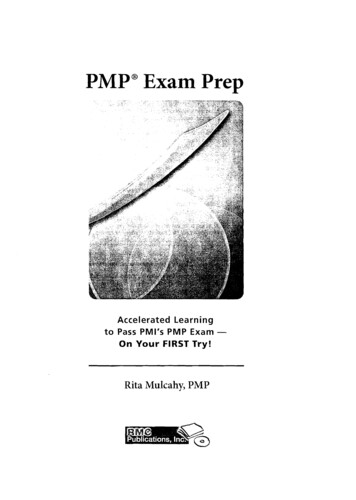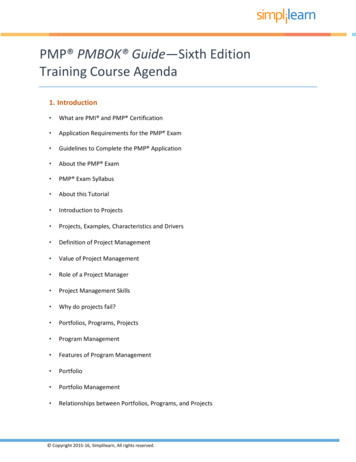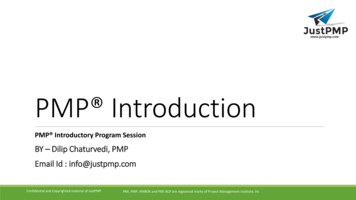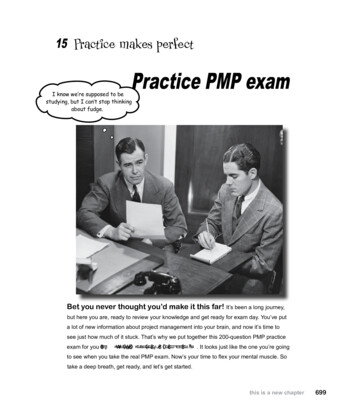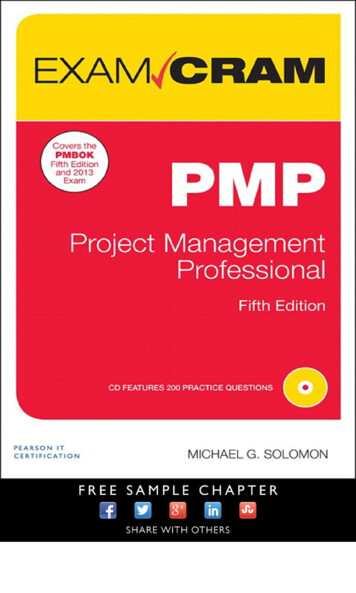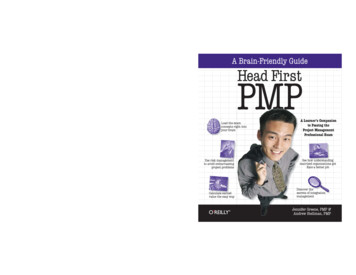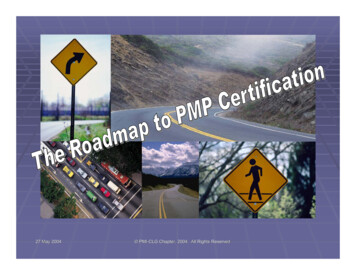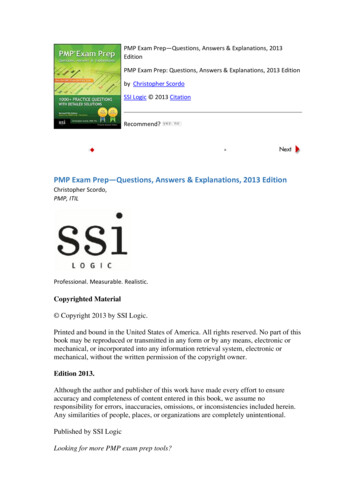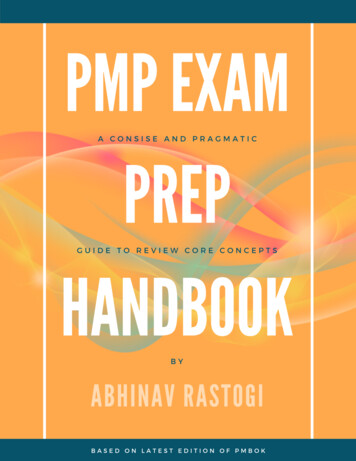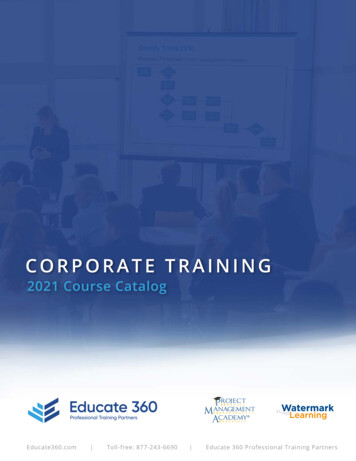
Transcription
Continue
Pmp exam prep simplified pdfPMP Exam Prep Simplified Andrew Ramdayal, PMP, PgMP, CISSP-ISSMP Editor: AJ Mercier BS, MS, MBA, PMP Copyright 2018 Technical Institute of America Inc. All rights reserved. Except as permitted under the United States Copyright Act of 1976, no part of this publication may be reproduced or distributed in any form or by any means orstored in a database or retrieval system, without the prior written permission of the publisher. By Andrew Ramdayal, PMP, PgMP, CISSP-ISSMP Third Printing: June 2018 ISBN-13: 978-1985728295 ISBN-10: 198572829X PMP, CAPM, PMI-ACP, PgMP, PMI-RMP, PMI-SP, PMBOK, Project Management Professional, Certified Associate in ProjectManagement (CAPM), Project Management Professional (PMP), PMI Agile Certified Practitioner (PMI-ACP), Program Management Professional (PgMP), PMI Risk Management Professional (PMI-RMP), PMI Scheduling Professional (PMI-SP), A Guide to the Project Management Body of Knowledge (PMBOK Guide), The PMI R.E.P Logo are registeredmarks of the Project Management Institute, Inc. Technical Institute of America has been reviewed and approved as a provider of project management training by the Project Management Institute (PMI). As a PMI Registered Education Provider (R.E.P), Technical Institute of America has agreed to abide by PMI established quality assurance criteria.Technical Institute of America 545 8th Ave New York, NY 10018 Phone: 212-564-2351 Fax: 800-490-7341 E-mail: [email protected] Web: www.tia.edu About the Author Andrew Ramdayal, PMP, PgMP, PMI-ACP, CISSP-ISSMP has over 15 years of project management experience in IT. He holds over 50 professional certifications in IT and accountingfrom vendors such as Microsoft, Cisco, CompTIA, and PMI. He also holds a Master Degree in Management Information System with a minor in project management. Andrew has worked on many ERP, IT Security, and computer networking projects over his career. Andrew has been teaching the PMP exam prep for over 10 years to thousands ofstudents all over the world. His unique teaching methods have allowed his students not only to pass the exam but also to apply the concepts in real life. He is currently the CEO of the Technical Institute of America which provides training to thousands of students every year in IT and medical courses. About Technical Institute of America TechnicalInstitute of America (TIA) is a nationally accredited school headquartered in New York City with locations in Arlington, VA, and San Francisco, CA. TIA is a PMI Registered Education Provider #3333. TIA provides online and in-person classes in most IT certifications and short term medical courses. Table of Contents Chapter 1 Introduction. . . . . . . . . . . . . . . . . . . . . . . . . . . . . . . . . . . . . . . . . . . . 1 PMBOK . . . . . . . . . . . . . . . . . . . . . . . . . . . . . . . . . . . . . . . . . . . . . . . . . . . . . . . . . . . . . . . . 1 Application Process. . . . . . . . . . . . . . . . . . . . . . . . . . . . . . . . . . . . . . . . . . . . . . . . . . . . . 2 Secret to Passing . . . . . . . . . . . . . . . . . . . . . . . . . . . . . . . . . . . . . . . . . . . . . . . . . . . . . . . 3 After Becoming Certified. . . . . . . . . . . . . . . . . . . . . . . . . . . . . . . . . . . . . . . . . . . . . . . 5 Chapter 2 Key Terms and Introduction to Project Management. . . . . . . 7 Life Cycles. . . . . . . . . . . . . . . . . . . . . . . . . . . . . . . . . . . . . . . . . . . . . . . . . . . . . . . . . . . . . 18 Agile. . . . . . . . . . . . . . . . . . . . . . . . . . . . . . . . . . . . . . . . . . . . . . . . . . . . . . . . . . . . . . . . . . 18 Key Terms and PM Processes Questions . . . . . . . . . . . . . . . . . . . . . . . . . . . . . . . . 21 Key Terms and PM Processes Answers. . . . . . . . . . . . . . . . . . . . . . . . . . . . . . . . . . . 26 Chapter 3 PM Processes and Role of the Project Manager. . . . . . . . . . . 31 Project Management Process Groups and Knowledge Areas . . . . . . . . . . . . . . 33 Common Inputs, Tools and Techniques, and Outputs (ITTO) . . . . . . . . . . . . . . .38 Common Inputs. . . . . . . . . . . . . . . . . . . . . . . . . . . . . . . . . . . . . . . . . . . . . . . . . . . . . . . . 38 Project Management Plan. . . . . . . . . . . . . . . . . . . . . . . . . . . . . . . . . . . . . . . . . . . . . . 41 Common Tools. . . . . . . . . . . . . . . . . . . . . . . . . . . . . . . . . . . . . . . . . . . . . . . . . . . . . . . . . 42 Common Outputs. . . . . . . . . . . . . . . . . . . . . . . . . . . . . . . . . . . . . . . . . . . . . . . . . . . . . .45 Updates (Project Management Plan, Project Documents, EEF, OPA) . . . . . . . 46 Role of the Project Manager. . . . . . . . . . . . . . . . . . . . . . . . . . . . . . . . . . . . . . . . . . . . 47 PMI Talent Triangle . . . . . . . . . . . . . . . . . . . . . . . . . . . . . . . . . . . . . . . . . . . . . . . . . . . . 48 Integration. . . . . . . . . . . . . . . . . . . . . . . . . . . . . . . . . . . . . . . . . . . . . . . . . . . . . . . . . . . . 50Project Management Processes Questions. . . . . . . . . . . . . . . . . . . . . . . . . . . . . . . 51 Project Management Processes Answers . . . . . . . . . . . . . . . . . . . . . . . . . . . . . . . . 56 Chapter 4 Project Integration Management . . . . . . . . . . . . . . . . . . . . . . . . 59 Develop Project Charter. . . . . . . . . . . . . . . . . . . . . . . . . . . . . . . . . . . . . . . . . . . . . . . . 61 Develop ProjectManagement Plan. . . . . . . . . . . . . . . . . . . . . . . . . . . . . . . . . . . . . . 65 Direct and Manage Project Work. . . . . . . . . . . . . . . . . . . . . . . . . . . . . . . . . . . . . . . . 69 Manage Project Knowledge . . . . . . . . . . . . . . . . . . . . . . . . . . . . . . . . . . . . . . . . . . . . 71 Monitor and Control Project Work . . . . . . . . . . . . . . . . . . . . . . . . . . . . . . . . . . . . . . 73 Perform IntegratedChange Control. . . . . . . . . . . . . . . . . . . . . . . . . . . . . . . . . . . . . 75 Close Project or Phase . . . . . . . . . . . . . . . . . . . . . . . . . . . . . . . . . . . . . . . . . . . . . . . . . 77 Integration Management Questions. . . . . . . . . . . . . . . . . . . . . . . . . . . . . . . . . . . . . 80 Project Integration Management Answers. . . . . . . . . . . . . . . . . . . . . . . . . . . . . . . 87 Chapter 5 Project ScopeManagement. . . . . . . . . . . . . . . . . . . . . . . . . . . . . . 91 Plan Scope Management. . . . . . . . . . . . . . . . . . . . . . . . . . . . . . . . . . . . . . . . . . . . . . . 92 Collect Requirements . . . . . . . . . . . . . . . . . . . . . . . . . . . . . . . . . . . . . . . . . . . . . . . . . . 94 Define Scope. . . . . . . . . . . . . . . . . . . . . . . . . . . . . . . . . . . . . . . . . . . . . . . . . . . . . . . . . . 98 Create WBS (Work BreakdownStructure). . . . . . . . . . . . . . . . . . . . . . . . . . . . . . 100 Validate Scope. . . . . . . . . . . . . . . . . . . . . . . . . . . . . . . . . . . . . . . . . . . . . . . . . . . . . . . 103 Control Scope . . . . . . . . . . . . . . . . . . . . . . . . . . . . . . . . . . . . . . . . . . . . . . . . . . . . . . . 105 Scope Management Questions. . . . . . . . . . . . . . . . . . . . . . . . . . . . . . . . . . . . . . . . 107 Scope Management Answers . . . . . . . . . . . . . . . . . . . . . . . . . . . . . . . . . . . . . . . . 115 Chapter 6 Project Schedule Management. . . . . . . . . . . . . . . . . . . . . . . . . . 119 Plan Schedule Management . . . . . . . . . . . . . . . . . . . . . . . . . . . . . . . . . . . . . . . . . . 120 Define Activities. . . . . . . . . . . . . . . . . . . . . . . . . . . . . . . . . . . . . . . . . . . . . . . . . . . . . 121 Sequence Activities . . . . . . . . . . . . . . . . . . . . . . . . . . . . . . . . . . . . . . . . . . . . . . . . . 123 Estimate Activity Durations. . . . . . . . . . . . . . . . . . . . . . . . . . . . . . . . . . . . . . . . . . . 127 Develop Schedule. . . . . . . . . . . . . . . . . . . . . . . . . . . . . . . . . . . . . . . . . . . . . . . . . . . . 131 Control Schedule . . . . . . . . . . . . . . . . . . . . . . . . . . . . . . . . . . . . . . . . . . . . . . . . . . . . 136 Hot Topic: Critical Path Method (CPM). . . . . . . . . . . . . . . . . . . . . . . . . . . . . . . . 139 Practice 1 . . . . . . . . . . . . . . . . . . . . . . . . . . . . . . . . . . . . . . . . . . . . . . . . . . . . . . . . . . . 144 Practice 2 . . . . . . . . . . . . . . . . . . . . . . . . . . . . . . . . . . . . . . . . . . . . . . . . . . . . . . . . . . . 148 Schedule Management Questions. . . . . . . . . . . . . . . . . . . . . . . . . . . . . . . . . . . . . 152 Project Schedule Management Answers. . . . . . . . . . . . . . . . . . . . . . . . . . . . . . 160 Chapter 7 Project Cost Management. . . . . . . . . . . . . . . . . . . . . . . . . . . . . . 165 Plan Cost Management. . . . . . . . . . . . . . . . . . . . . . . . . . . . . . . . . . . . . . . . . . . . . . . 166 Estimate Costs. . . . . . . . . . . . . . . . . . . . . . . . . . . . . . . . . . . . . . . . . . . . . . . . . . . . . . . 167 Determine Budget. . . . . . . . . . . . . . . . . . . . . . . . . . . . . . . . . . . . . . . . . . . . . . . . . . . 171Control Costs. . . . . . . . . . . . . . . . . . . . . . . . . . . . . . . . . . . . . . . . . . . . . . . . . . . . . . . . 174 Hot Topic: Earned Value Management . . . . . . . . . . . . . . . . . . . . . . . . . . . . . . . . 176 Scenario 1: . . . . . . . . . . . . . . . . . . . . . . . . . . . . . . . . . . . . . . . . . . . . . . . . . . . . . . . . . . 178 Scenario 2: . . . . . . . . . . . . . . . . . . . . . . . . . . . . . . . . . . . . . . . . . . . . . . . . . . . . . . . . . . 181Scenario 3: . . . . . . . . . . . . . . . . . . . . . . . . . . . . . . . . . . . . . . . . . . . . . . . . . . . . . . . . . . 183 Scenario 4: . . . . . . . . . . . . . . . . . . . . . . . . . . . . . . . . . . . . . . . . . . . . . . . . . . . . . . . . . . 185 Cost Management Questions. . . . . . . . . . . . . . . . . . . . . . . . . . . . . . . . . . . . . . . . . 187 Project Cost Management Answers . . . . . . . . . . . . . . . . . . . . . . . . . . . . . . . . . . . 194Chapter 8 Project Quality Management. . . . . . . . . . . . . . . . . . . . . . . . . . . 199 Plan Quality. . . . . . . . . . . . . . . . . . . . . . . . . . . . . . . . . . . . . . . . . . . . . . . . . . . . . . . . . 202 Manage Quality. . . . . . . . . . . . . . . . . . . . . . . . . . . . . . . . . . . . . . . . . . . . . . . . . . . . . . 205 Control Quality. . . . . . . . . . . . . . . . . . . . . . . . . . . . . . . . . . . . . . . . . . . . . . . . . . . . . . 209 QualityManagement Questions . . . . . . . . . . . . . . . . . . . . . . . . . . . . . . . . . . . . . . 214 Project Quality Management Answers. . . . . . . . . . . . . . . . . . . . . . . . . . . . . . . . . 220 Chapter 9 Project Resource Management . . . . . . . . . . . . . . . . . . . . . . . . . 223 Plan Resource Management. . . . . . . . . . . . . . . . . . . . . . . . . . . . . . . . . . . . . . . . . . 224 Estimate Activity Resources . . . . . . . . . . . . . . . . . . . . . . . . . . . . . . . . . . . . . . . . . 228 Acquire Resources . . . . . . . . . . . . . . . . . . . . . . . . . . . . . . . . . . . . . . . . . . . . . . . . . . . 230 Develop Team . . . . . . . . . . . . . . . . . . . . . . . . . . . . . . . . . . . . . . . . . . . . . . . . . . . . . . . 232 Manage Team . . . . . . . . . . . . . . . . . . . . . . . . . . . . . . . . . . . . . . . . . . . . . . . . . . . . . . . 237 Control Resources . . . . . . . . . . . . . . . . . . . . . . . . . . . . . . . . . . . . . . . . . . . . . . . . . . 240 Human Resource Management Questions . . . . . . . . . . . . . . . . . . . . . . . . . . . . . 242 Project Human Resource Management Answers. . . . . . . . . . . . . . . . . . . . . . . . 249 Chapter 10 Project Communications Management. . . . . . . . . . . . . . . . . 253 Plan Communications Management. . . . . . . . . . . . . . . . . . . . . . . . . . . . . . . . . . 254 Manage Communications. . . . . . . . . . . . . . . . . . . . . . . . . . . . . . . . . . . . . . . . . . . . . 259 Monitor Communications. . . . . . . . . . . . . . . . . . . . . . . . . . . . . . . . . . . . . . . . . . . . . 262 Communications Management Questions . . . . . . . . . . . . . . . . . . . . . . . . . . . . . 264 Project Communications Management Answers. . . . . . . . . . . . . . . . . . . . . . . 272 Chapter 11 Project Risk Management. . . . . . . . . . . . . . . . . . . . . . . . . . . . . 277 Plan Risk Management. . . . . . . . . . . . . . . . . . . . . . . . . . . . . . . . . . . . . . . . . . . . . . . 279 Identify Risks. . . . . . . . . . . . . . . . . . . . . . . . . . . . . . . . . . . . . . . . . . . . . . . . . . . . . . . . 281 Perform Qualitative Risk Analysis . . . . . . . . . . . . . . . . . . . . . . . . . . . . . . . . . . . . . 285 Plan RiskResponses . . . . . . . . . . . . . . . . . . . . . . . . . . . . . . . . . . . . . . . . . . . . . . . . . 292 Implement Risk Responses . . . . . . . . . . . . . . . . . . . . . . . . . . . . . . . . . . . . . . . . . . . 296 Monitor Risks. . . . . . . . . . . . . . . . . . . . . . . . . . . . . . . . . . . . . . . . . . . . . . . . . . . . . . . . 298 Risk Management Questions . . . . . . . . . . . . . . . . . . . . . . . . . . . . . . . . . . . . . . . . . 300 Project RiskManagement Answers. . . . . . . . . . . . . . . . . . . . . . . . . . . . . . . . . . . . 307 Chapter 12 Project Procurement Management. . . . . . . . . . . . . . . . . . . . 311 Plan Procurement Management . . . . . . . . . . . . . . . . . . . . . . . . . . . . . . . . . . . . . . 313 Conduct Procurement. . . . . . . . . . . . . . . . . . . . . . . . . . . . . . . . . . . . . . . . . . . . . . . . 317 Control Procurement . . . . . . . . . . . . . . . . . . . . . . . . . . . . . . . . . . . . . . . . . . . . . . . 319 Procurement Management Questions. . . . . . . . . . . . . . . . . . . . . . . . . . . . . . . . . 322 Project Procurement Management Answers . . . . . . . . . . . . . . . . . . . . . . . . . . . 327 Chapter 13 Project Stakeholder Management . . . . . . . . . . . . . . . . . . . . . 331 Identify Stakeholders . . . . . . . . . . . . . . . . . . . . . . . . . . . . . . . . . . . . . . . . . . . . . . . 332 Plan Stakeholder Engagement. . . . . . . . . . . . . . . . . . . . . . . . . . . . . . . . . . . . . . . . 335 Manage Stakeholder Engagement . . . . . . . . . . . . . . . . . . . . . . . . . . . . . . . . . . . . 337 Monitor Stakeholder Engagement . . . . . . . . . . . . . . . . . . . . . . . . . . . . . . . . . . . . 339 Stakeholder Management Questions. . . . . . . . . . . . . . . . . . . . . . . . . . . . . . . . . 341 Project Stakeholder Management Answers . . . . . . . . . . . . . . . . . . . . . . . . . . . . 347 Chapter 14 Ethics and Exam Tips. . . . . . . . . . . . . . . . . . . . . . . . . . . . . . . . . . 349 Professional Responsibility . . . . . . . . . . . . . . . . . . . . . . . . . . . . . . . . . . . . . . . . . . . 349 Things to Memorize. . . . . . . . . . . . . . . . . . . . . . . . . . . . . . . . . . . . . . . . . . . . . . . . . . 351Important Outputs by Process Groups . . . . . . . . . . . . . . . . . . . . . . . . . . . . . . . . 353 Description of Project Documents and Processes Created . . . . . . . . . . . . . . 354 Study Steps . . . . . . . . . . . . . . . . . . . . . . . . . . . . . . . . . . . . . . . . . . . . . . . . . . . . . . . . . 357 Project Code of Ethics and Professional Conduct Questions. . . . . . . . . . . . . 360 Project Code of Ethicsand Professional Conduct Answers . . . . . . . . . . . . . . 367 Chapter 15 Mock Exam . . . . . . . . . . . . . . . . . . . . . . . . . . . . . . . . . . . . . . . . . . . 371 Final Exam Answers. . . . . . . . . . . . . . . . . . . . . . . . . . . . . . . . . . . . . . . . . . . . . . . . . . 422 Glossary. . . . . . . . . . . . . . . . . . . . . . . . . . . . . . . . . . . . . . . . . . . . . . . . . . . . . . . . . 445 Index. . . . . . . . . . . . . . . . . . . . . . . . . . . . . . . . . . . . . . . . . . . . . . . . . . . . . . . . . . . 453 Chapter 1 Introduction The PMP exam is one of the world’s most recognized well-respected certifications in Project Management. A PMP certification generally means better pay and more respect from your peers. Getting the certification will not be an easy task to accomplish. The exam is difficult and eventhe application process is not very easy. Over my 10-plus-year career of teaching toward this exam, I have developed many tips and tricks that allowed thousands of students to pass this exam on the first try. I believe if you follow my tips and guidance throughout this book, and especially in the last chapter with the exam tips you can successfully passthis exam the very first time. When I decided to write this book, I didn’t want to write 600-plus pages of content to read and comprehend. I wanted to write a condensed book featuring just the information that you need to know to pass the tests and include lots of practice questions to give students the look and feel of an actual PMP exam. I’ve writtenthis book from a first-person perspective, as if I were actually teaching a class. That means that I will address you, the reader, as my student. PMBOK The PMP exam is based on the current version of the PMBOK Guide Version 6. PMBOK, which stands for Project Management Body of Knowledge, is a book of best practices for managing a project. Itoutlines all of the processes that a project will follow from beginning to end. It is these processes that we will be studying in this book. What people fail to understand is that the PMBOK is not an exam study guide. There are many topics that we will cover in this book that are not in the PMBOK. The PMBOK does not have any practice questions orexam tips. This book will cover the PMBOK in detail and include just what you need to know to pass the exam. Topics that were left out of this book generally won’t show up on your exam. The PMBOK is a very difficult book to read. Most of my students have a hard time understanding it and making sense of what is in there. If you are looking to simplypass your exam, then this book is what you need. You can attempt to read the PMBOK, but I will congratulate you if you can get past the first five pages without falling asleep. It is probably the world’s best sleeping aid. 1 PMP Exam Prep Simplified Application Process The PMP has quite a few requirements and a lengthy application process-not hard,but long. Here are the current requirements. The PMP exam requires: 35 hours of project management education. You can get this from any registered PMI education provider. You can search for it on the PMI website. My company, Technical Institute of America, offers boot camps and online classes that will get you to 35 hours of projectmanagement education. A number of years of project management education, depending on your highest level of education as follows: Bachelor’s degree(or higher) requires 36 months of experience and 4,500 hours. You must have both. If you have been working full-time in Project Management, you should be able to show about 4,500-6,000hours (50 weeks times 40 hours a week equals 2,000 hours per year, times 3) If you have anything lower than a bachelor’s degree, such as a high school diploma, you will need 60 months of experience and 7,500 hours. 60 months is about 10,000 hours; therefore, coming up with the minimum should be no problem. All work experience must bewithin the last eight years from the date of your application. You are going to need approval from a sponsor or manager at the companies where you’ve worked to verify your work experience. You need to get their contact information to enter on the application. Here is the general process you will follow to become PMP Certified: These are justthe basic steps you will need to take to get the actual certification. You will also need the 35 contact hours. This should come from a project management course. Apply for the exam online and submit the application. PMI will take about a week to approve the application. After you get an approval, you can then schedule the exam at any Prometrictesting center (www.prometric.com). You cannot schedule this exam without first getting approval from PMI. 2 Chapter 1 - Introduction Exam Stats 200 questions. 175 count toward your score; 25 do not. You will not know which 25 questions those are. Your objective is simply to get as many right as possible. 4 hours. This is just enough timeto complete the exam. Most people will need the entire four hours to finish it. The questions are long and hard. When you complete the exam, it will you tell right away if you passed or failed. The exam does not give a numerical score. It’s either pass or fail. The exam is broken down into 5 process groups as follow: Process Group % of QuestionTotal Questions Initiating 13% 26 Planning 24% 48 Executing 31% 62 Monitoring and controlling 25% 50 Closing 7% 14 Total questions: Closing Monitor and Controlling Initiation Planning Executing 200 Each of the process groups is comprised of processes that we will be reviewing in this book. The exam consists of multiple choice questions. Therewill always be 4 choices to choose from. You will have to choose the best of the four. There are formulas you will need to know (don’t worry; they are easy to remember), and diagrams to draw. Secret to Passing My students always ask me, is there a secret to passing this exam? My general answer is yes! You see, most certification exams test how wellyou memorize something, but this exam does not only do that. The real secret is not just to memorize it, but to thoroughly understand it. The PMP exam tests your ability to apply the concepts that are taught to you in the PMBOK. I always tell my students that if you memorize the entire book you will have an excellent chance of failing the exam. Youneed to understand the concepts and how to apply them, not merely memorize them. This exam is difficult because it is not about selecting the correct answer, but selecting the best answer. This means that most of the questions will have at least two choices that are correct and you will have to choose the best response for that question. I havedeveloped two rules that all my students should follow when studying for this exam: 1. Do not question the PMBOK. 2. Forget your experience. 3 PMP Exam Prep Simplified This book was written to help you pass an exam, not to justify the PMBOK. I know many of my students want to dispute the best practices of the PMBOK, but that will not helpanyone pass an exam. If the study guide says you must do something a certain way, then do it that way to pass your exam. I have always told my students if the PMBOK says the wall is black, then the wall is black and don’t question that. If you’re studying and you start to say things like, “this will not work” or “who does this in real life”, you nowsetting yourself up for failure. Always remember, the PMBOK is always correct. Experience is a problem on this exam. The more experience in real-world project management you have, the more likely you are to fail the exam. I know this might sound crazy, but I have seen this time and time again. The exam doesn’t test what you would do in a specificscenario, but what the PMBOK would do in a specific scenario. Applying what you have been doing for years might not be the correct way, according to the PMBOK. As you read this study guide, please forget everything that you have ever learned about from your job in real-life project management. The moment you enter the classroom or exam room,clear your mind of everything you have done in the past. Assume you have never done project management. Start with a blank mind and whatever that is taught to you is the way it should be done. This will help you see things from the PMBOK’s perspective. Exam Tip: As you answer questions on this exam ask yourself what would be a PMBOKanswer? In the last chapter of this book, “Exam Tips,” I will review some key things to look for on the exam when selecting an answer. 4 Chapter 1 - Introduction After Becoming Certified Passing the PMP exam means you have put in a lot of time to study and almost an entire day to take an exam. Right after you finish the exam on the computer, it willtell you if you passed or failed. If you pass, you are certified from that moment on. If you fail, you will have the chance to retake the exam. You can retake the exam up to two more times after the first attempt. After that, you must wait one year before resubmitting your application. Once you pass, you are instantly certified-but you will need to do morework to hold onto the certification. You will need to maintain the certification or you could lose it after 3 years. You will be required to earn 60 PDU (Professional Development Units) every 3 years or you could lose your certification. Earning the PDU is done in the following ways: Taking classes relating to project management. These can be liveclasses or online classes. Most people will get them this way. Generally, for every hour of class you will get 1 PDU. Attending PMI chapter meetings. Every month, the local PMI chapter will hold a meeting with its members. If you are a member and attend, you can get about 1-2 PDUs. Reading books or articles. Volunteering at PMI or othernonprofit organizations. I know you’re not currently worried about renewing your PMP, since you are not certified yet, but it’s good to keep this in the back of your mind. Three years go by very fast and no one wants to retake this exam. 5 PMP Exam Prep Simplified 6 Chapter 2 Key Terms and Introduction to Project Management Key Terms PMBOK(Project Management Body of Knowledge) Version 6 The PMBOK is currently in its 6th edition. The PMBOK was originally published in 1996. The PMBOK has been consistently updated every four to five years. When you get certified in one PMBOK you do not need to be certified in another; all you have to do is maintain the certification. The PMBOKwas written by a large body of very smart folks that came together to write standards of how to manage a project. One has to ask: Do all projects from different industries follow a standard set of processes? The answer is yes, they do, and that’s what a PMBOK maps out. If we were to take 10 random folks from different industries, sit them down, andtell them, “I want you guys to write a book that standardizes the way all projects are managed,” what would that standard be? What would those processes be? That is what the PMBOK is. It is just a book that’s written by a lot of different folks to standardize the way a project is actually managed. Project A temporary endeavor to create a uniqueproduct, service, or result. A project by definition is temporary; it does not mean short or long. A project could be something as simple as painting a room, a task that will last for a few days, or something long-term, such as building a complex application, which could last two to four years. The key point is that all projects must be temporary, and theyhave a start date and an end date. The output of the project has to be unique and is unique to the customer. In other words, the customer hasn’t done this before. Even though a project is unique and temporary, the output of the project, the main deliverable, will be around for very long time, such as constructing a large building that will be used forhundreds of years. Examples of projects can include: Building a house. Creating new software. Installing a new computer network. Redesigning a process in a company. Merging different organizations. 7 PMP Exam Prep Simplified Operations Operations are the opposite of projects. Operations deal with day-to-day work in abusiness. One of the main differences between projects and operations is that one is temporary and the other is ongoing. Operations have no start date or end date. An example would be sales: that’s something you do every day. Providing IT support is also operations. If you’re building cars on an assembly line, that is also operations, because theoutput is not unique and there is no start or end date. The main difference for your exam is: projects are temporary and unique, whereas operations have no start date, no end date, and are not unique. Progressive Elaboration Progressive elaboration involves discovering greater levels of detail as the project moves toward completion. This is alsoknown as “rolling wave planning.” The easiest way to think of it is that as time progresses, things get more detailed. At the beginning of a project, you may not know the specific details of what you want to do. Example: I want to build a house for my family in the suburbs of New York City but do I know what suburb? It could be upstate or part ofConnecticut or Long Island. I may know a high-level cost, but not a detailed cost. As the project progresses, things will become more elaborated. A few weeks into this project, I may know exactly where I want to live and how big the house will be. Project Management Project management is the application of knowledge, skills, tools, and techniques tothe project work to meet the project requirements. Project management is about managing people to accomplish the scope of the project in the given constraints of time and costs. All projects are limited as to time, cost, and scope. In project management our goal, is to get work done within a specific budget and a specific timeframe. You will be usingyour skills, tools and techniques to finish the activities. Example: If I were to paint a room, what activities would I need to do? I’d need to buy the paint, remove the furniture, paint the walls, and put t
It is probably the world’s best sleeping aid. 1 PMP Exam Prep Simplified Application Process The PMP has quite a few requirements and a lengthy application process-not hard, but long. Here are the current requirements. The PMP exam requires: 35 hours of project management education. You
